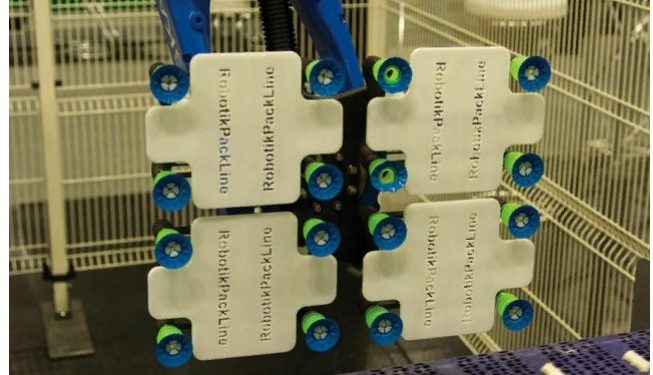This year’s Anuga FoodTec trade fair in Cologne, Germany, which saw some 43,000 visitors, highlighted new food processing technology from around the world. Arguably, the most visited exhibit was the Robotik-Pack-Line (RPL), a complex packaging solution designed specifically for convenience snacks. Created as a live demonstration just for the trade fair, the high-speed line combines more than a dozen modules, all of which work together harmoniously at high speeds.
The system, which was designed to package a handy vegetable and dip-filled “snack-and-go” container, will make a huge difference in food technology, since it utilizes some of the world’s most innovative technology, said RPL network manager Rolf Peters.
At the center of the system is the linecontrol module, designed by RBL partner CSB-System. It is responsible for managing the entire production process. The system’s efficiency is constantly under surveillance and, if necessary, it can be adjusted to create even greater efficiency. RPL partners, including Kronen, SES, Akon Robotics, SMC Pneumatik and others, all have modules that are compatible with or of similar technology to that of linecontrol. Efficiency and speed are otherwise compromised, said Peters.
Here is how the system lines up, including many of its individual modules and their functions.
At the control center module of the CSB-System, CSB linecontrol controls and visualizes all system components. The system, said Peters, reduces unexpected delays and shutdowns.
The next module on the line is the GS 10-2, an all-purpose belt-cutting machine. It is used for salad, lettuce, vegetables, fruits and other items. Its designers say it is ideal for use in large kitchens, catering and in industrial applications.
Following the belt-cutting machine is a feeding belt designed specifically for mini vegetables. A spokesperson from Kronen, its designer, said the in-feed belt ensures the continuous transport of cut products. The speed of the belt is fully adjustable and can be set to meet the speed of surrounding modules.
Moving product needs to be packed, and that is the job of the Motoman MPP3 Delta Picker. The Delta Picker grabs three different types of vegetables and a dip from the conveyor belt at a rate of 60 picks per minute and then puts them into specific compartments of a thermoformed tray. Since the Delta Picker’s gripper is lightweight and has soft jaws, it is designed for handling delicate food. Made entirely from FDA-conforming materials, the gripper is equipped with an easy-to-handle, quick-change system.
The robot uses camera inspection technology to know exactly where to place the vegetables and dip. Vegetables are identified on the feeder, enabling the robot to place the correct vegetable in the exact right tray.
Once packed, a flat vacuum gripper, designed specifically to handle four veggie packs at one time, safely transports the packages down the line to be sealed by the Thermoformer FP 2000 XL. From there, the product, which arrives in two lines, needs to be separated. This is done by a six-axis articulated robot, Motoman MH12, which receives the trays and deposits them into a single line.
Before being packaged and palletized, the individual packages need to be inspected for leaks, foreign parts and correct labeling. First, it passes through a leak detector, MAPAX LD, made by Linde AG. Then it moves through a foreign matter-detection x-ray system designed by Mettler Toledo, MAPAX LD. The next module, the CombiChecker CM3570, offers FDA-approved weighing and metal detection in one process.
Finally, the products pass through the SES Labeller, designed by Straßburg Etikettier Service, and then on to the final inspection system, CLS200, another design by Mettler Toledo. The Linescan technology checks front-of-pack and back-of-pack labels at the same time. It also verifies 1D and 2D bar codes.
With all packages inspected, it’s time for packaging. The product is moved by yet another robotic system, the LR Mate 200, to be boxed. A case erector, the Tablomat ST-LE, works in unison with a robot module, the RoboInfild 6A, to form and fold cases with stacking flaps from flat cardboard blanks. A six-axis robot packs the product trays into the cases. Due to the closed stacking flaps, the trays are loaded by way of a swiveling motion.
Fully packaged, the product moves by way of a high-speed robot, Motoman MH50-3511, to be glued and labeled. The six-axis version allows for different orientation in the pick-up and place area. Finally, the boxes are palletized using another robotic system and placed in a predefined layer pattern on a euro-pallet.
The Robotik line is an example of “Industry 4.0,” a term for the merging of production technologies, products and the Internet.
“The aim is the creation of a smart factory, which is characterized by adaptability, resource efficiency and ergonomics, while including customers and business partners in the process,” said Herbert Buckenhüskes, director of food technology with the German Agricultural Society.
“Currently, nobody really knows how significant Industry 4.0 will become for food production, because the consumer will also play an important part in this,” he said. “However, Industry 4.0 promises many new features for future food production tasks.”








